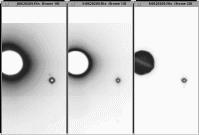
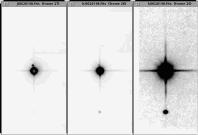
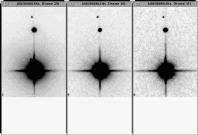
Fields containing Jupiter and its moons were observed during normal survey operations by the southern 2MASS facility on 1998 September 21 (980921s) and September 24 (980924s). There is no guarantee beforehand that 2MASS will observe any of the planets, and this event was merely a lucky coincidence (or unlucky, considering that 18 survey scans have to be reobserved with Jupiter out of the way). Needless to say, Jupiter is badly saturated in J and H. At Ks, methane absorption in Jupiter's atmosphere dims the planet and you can start to see some of the cloud bands. Three of the four Galilean satellites were also observed. Europa was occulted by Jupiter at the time, and Io, Ganymede and Callisto are all saturated.
An interesting question was whether or not any of the other moons fell in the observed tiles and whether or not they were visible. Using the JPL ephemeris program Horizons, we obtained predicted coordinates for the 12 minor Jovian satellites during 980921s and then searched the corresponding scans for possible sightings. We were able to find most of them. The moons that were not visible were also the smallest, and therefore the faintest, objects.
The moon Ananke was located too far from Jupiter to be observed in the range of tiles on 980921s, but the predicted location was scanned a few days later on 980924s.
Table 1 lists the observations of all of Jupiter's moons as observed by 2MASS. Positions for visible objects are from the 2MASS point source lists; for invisible objects, they are the predicted positions from Horizons, and are good to 1´´-2´´, since only the starting and ending time of the scan were readily available.
Figures 1-12 below display the corresponding 2MASS images. The non-observations of Ananke and Leda are also included. The images are usually centered on the moon.
See also "Near-Infrared Observations of the Outer Jovian Satellites," M.V. Sykes, B. Nelson, R.M. Cutri, J.D. Kirkpatrick, R.L. Hurt, & M. Skrutskie, 2000, Icarus, 143, 371.
|
|
|
|
|
|
|
|
| Io | 23 34 28.22 | -04 27 36.4 | 980921s | 062 | 209 | visible and saturated |
| Europa | 23 34 34.05 | -04 26 49.3 | 980921s | 062 | 209 | not visible - in occultation |
| Ganymede | 23 34 54.96 | -04 24 35.4 | 980921s | 062 | 198 | visible and saturated |
| Callisto | 23 35 13.02 | -04 22 23.2 | 980921s | 069 | 080 | visible and saturated |
| Amalthea | 23 34 34.07 | -04 26 57.0 | 980921s | 062 | 209 | not visible - in transit or occultation |
| Himalia | 23 34 10.93 | -03 51 40.7 | 980921s | 061 | 092 | visible |
| Elara | 23 32 45.35 | -04 50 37.8 | 980921s | 058 | 221 | visible |
| Pasiphae | 23 42 17.26 | -04 44 33.4 | 980921s | 096 | 221 | visible |
| Sinope | 23 41 12.55 | -04 40 11.8 | 980921s | 087 | 056 | visible |
| Lysithea | 23 36 54.55 | -03 40 11.5 | 980921s | 073 | 103 | visible |
| Carme | 23 40 11.41 | -03 38 18.4 | 980921s | 085 | 103 | visible |
| Ananke | 23 29 24.23 | -04 22 26.4 | 980924s | 055 | 198 | not visible - too faint |
| Leda | 23 35 06.24 | -04 02 51.5 | 980921s | 069 | 092 | not visible - too faint |
| Thebe | 23 34 29.68 | -04 27 30.7 | 980921s | 062 | 209 | visible between Jupiter and Io, just above Io's diffraction spike, best at Ks |
| Adrastea | 23 34 31.99 | -04 27 15.5 | 980921s | 062 | 209 | not visible - lost in Jupiter's glare just off western limb |
| Metis | 23 34 33.61 | -04 27 00.9 | 980921s | 062 | 209 | not visible - in transit or occultation |

|

|
 |
| Figure 1 | Figure 2 | Figure 3 |
| Io | Ganymede | Callisto |
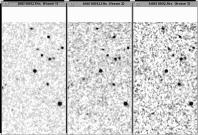
|
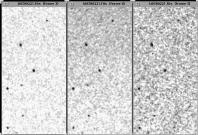
|
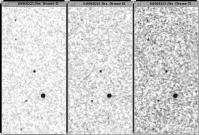 |
| Figure 4 | Figure 5 | Figure 6 |
| Himalia | Elara | Pasiphae |
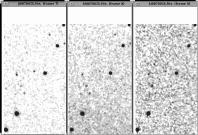
|
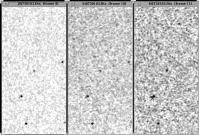
|
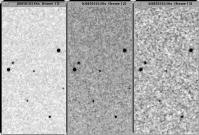 |
| Figure 7 | Figure 8 | Figure 9 |
| Sinope | Lysithea | Carme |
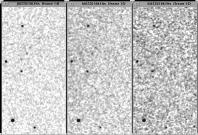
|
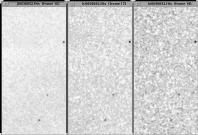
|
 |
| Figure 10 | Figure 11 | Figure 12 |
| Ananke | Leda | Thebe |
[Last Update by B. Nelson. Modified 2000 Sep 22 by S. Van Dyk]